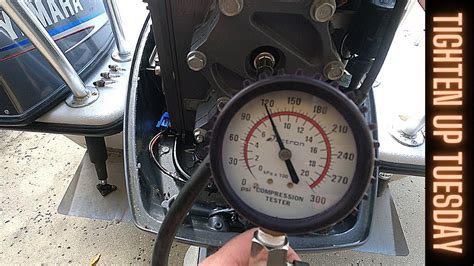How To Check Compression On An Outboard Motor
Ronan Farrow
Mar 23, 2025 · 4 min read

Table of Contents
How to Check Compression on an Outboard Motor
Maintaining your outboard motor is crucial for ensuring its longevity and performance. One key aspect of this maintenance is regularly checking the compression. Low compression can indicate a variety of problems, from worn piston rings to damaged cylinders, significantly impacting your engine's power and efficiency. This guide will walk you through how to check compression on your outboard motor, helping you identify potential issues early on.
Why Check Compression?
Before diving into the how-to, let's understand why checking compression is important. Low compression can lead to:
- Reduced engine power: A significant drop in compression means less power generated during combustion. You'll notice a lack of acceleration and overall sluggish performance.
- Hard starting: Low compression makes it harder for the engine to turn over and start. You might experience prolonged cranking or even failure to start altogether.
- Increased fuel consumption: With less efficient combustion, your engine will burn more fuel to achieve the same level of power.
- Engine damage: Continuing to operate an outboard with low compression can cause further damage, leading to costly repairs.
Regular compression checks are a preventative measure that can save you time, money, and frustration in the long run.
Tools You'll Need
To accurately check your outboard's compression, you'll need the following tools:
- Compression gauge: This specialized tool measures the pressure within the cylinders. Ensure it's compatible with your outboard's spark plug thread size.
- Spark plug wrench: Used to remove and install the spark plugs. Again, make sure it's the correct size for your outboard.
- Shop rags or towels: To keep the area clean and prevent damage.
- Owner's manual: Consult your owner's manual for specific instructions and recommended compression ranges for your outboard model. This is crucial for accurate interpretation of your results.
Step-by-Step Guide to Checking Compression
Note: Always disconnect the battery's negative terminal before starting any work on your outboard motor. Safety first!
- Prepare the engine: Ensure the engine is cool and the spark plugs are easily accessible.
- Remove the spark plugs: Use the spark plug wrench to carefully remove all spark plugs. Clean the spark plug threads and the area around them to prevent debris from falling into the cylinder.
- Install the compression gauge: Screw the compression gauge into the spark plug hole of one cylinder. Make sure it's tightly seated.
- Crank the engine: Have a helper crank the engine over several times until the gauge reading stabilizes. This will take several seconds. Ensure the throttle is fully open while cranking.
- Record the reading: Note the highest reading displayed on the gauge. This is the compression reading for that cylinder.
- Repeat for each cylinder: Repeat steps 3-5 for each cylinder on your outboard motor. Record each reading carefully.
- Compare readings: Compare the readings you've obtained with the specifications in your owner's manual. Significant variations between cylinders indicate potential problems. Generally, a difference of more than 10-15 PSI between cylinders warrants further investigation.
Interpreting Your Results
Once you've recorded the compression readings, compare them to the specifications in your owner's manual. If any readings are significantly lower than the recommended range, it's crucial to address the issue promptly. Low compression could be caused by a variety of factors, including:
- Worn piston rings: These rings seal the combustion chamber, and wear can lead to significant compression loss.
- Damaged cylinder walls: Scratches or scoring on the cylinder walls can reduce compression.
- Burnt or leaking valves: If valves are damaged or not sealing properly, compression will escape.
- Head gasket issues: A blown head gasket can also cause compression loss.
When to Seek Professional Help
If you are uncomfortable performing this procedure yourself, or if you find low compression readings, it's advisable to consult a qualified marine mechanic. They have the expertise and tools to diagnose the problem accurately and perform the necessary repairs.
By regularly checking your outboard motor's compression, you can proactively identify and address potential issues, ensuring your engine runs smoothly and efficiently for years to come. Remember safety first and always consult your owner's manual for specific instructions and recommendations.
Featured Posts
Also read the following articles
| Article Title | Date |
|---|---|
| How To Build Deer Skinning Rack | Mar 23, 2025 |
| How Much Money Is A Go Kart | Mar 23, 2025 |
| How Much Pag Oil To Add When Replacing Compressor | Mar 23, 2025 |
| How Much Power Can A 6l80e Handle | Mar 23, 2025 |
| How Much Is Good Inside Membership | Mar 23, 2025 |
Latest Posts
-
How Many Days Since Michigan Beat Ohio State
Apr 07, 2025
-
How Many Days Of Daycare Is Best
Apr 07, 2025
-
How Many Days In Yakushima
Apr 07, 2025
Thank you for visiting our website which covers about How To Check Compression On An Outboard Motor . We hope the information provided has been useful to you. Feel free to contact us if you have any questions or need further assistance. See you next time and don't miss to bookmark.
